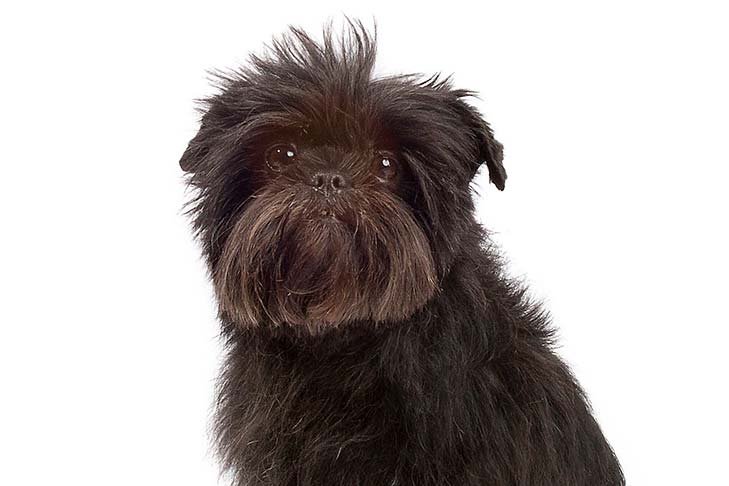Affenpinscher
BREED INFO
- Group – Toy
- Height – 9 to 11.5 inches at the shoulder
- Weight – 3-6 KG
- Life Span – 12-14 years
The Affenpinscher, whose name translated from German means “monkey-like terrier”, is one of the most ancient of all toy breeds. Also known as the Monkey Pinscher, the Monkey Dog, the Monkey Terrier, the Black-Mustached Devil or simply the Affen, this is a lively, sturdy little dog whose intelligence, disposition and size make it a wonderful house dog and companion. The Affenpinscher has a neat but shaggy appearance with an endearing facial expression accentuated by a flat face, a prominent chin, bushy eyebrows, a mustache and a beard. The Affenpinscher is known for being courageous, reliable and inquisitive. Legend has it that one Affen faced up to an angry stallion, and another confronted a grown grizzly bear on a trip with its owner to the Alaskan wilderness. The Affenpinscher was recognized by the American Kennel Club in 1936, as a member of the Toy Group.
History

Affenpinschers were developed in Germany, where in the 16th and 17th centuries they were used to control the rodent population in kitchens, granaries, shops and stables. Over time, they were bred down in size and became equally welcomed as household companions, while still keeping mice and rats at bay. The ancestry of the Affenpinscher is not well-documented. Many fanciers speculate that German Pinschers were mated with imported Asian breeds to create the flat-faced Affen. Regardless of its own ancestry, the Affenpinscher was a significant contributor to the development of many other small, rough-coated European breeds, including the Miniature Schnauzer and the Brussels Griffon. Affenpinschers almost disappeared during World War II. When the war ended, fanciers crossed the remaining German stock with the Griffon Bruxellois, which exaggerated the unique face that identifies the breed today.
The Pinscher Klub was founded in 1895 in Cologne. In 1907, the Bayerischer Schnauzer Klub was formed. In 1923, these two clubs merged and became the Pinscher-Schnauzer Klub. The Affenpinscher was admitted to the American Kennel Club Stud Book in 1936. For some reason, this breed has never enjoyed immense popularity. In 1998, only 87 Affenpinschers were registered in all of Great Britain, making this a rare breed. Today’s Affenpinscher excels in agility, rally and obedience disciplines, as well as in the conformation ring. He also is an excellent therapy dog. Mostly, however, the Affenpinscher is an affectionate companion and charming lap-warmer.
Personality and Temperament
Affenpinschers are very intelligent, loyal, alert, and friendly. Affenpinschers are small dogs who carry themselves with great confidence. Affenpinschers are somewhat territorial when it comes to their toys and food, so they are not recommended for homes with very small children. This dog is mostly quiet, but can become very excited if attacked or threatened, and shows no fear toward any aggressor.

This breed gets along well with children, other Affenpinschers, and even other types of household pets. They are often alarmed by unknown visitors, however. Affenpinschers are tiny, but they have large personalities. They take themselves very seriously and require everyone else to take them seriously as well, resulting in humorous interactions with people. Their terrier blood makes them spunky and sassy, and many owners wonder if these tiny toy dogs know just how small they really are. Mostly seen as “purse dogs” by ladies around the world, the Affen is a lovely travel companion, easy-going and accepting of new situations. Just keep an eye on the Affenpinscher about town, this breed can be mischievous.
Hair, Care and Grooming
The AKC calls the Affenpinscher’s appearance, “shaggy but neat.” Affenpinschers have a thick, rough coat that is about one inch think on the body, and becomes shorter toward the hindquarters and longer toward the head, creating a mane around the face
Maintaining the desired appearance of the Affenpinscher requires a lot of grooming. They need to be brushed several times a week with both a slick brush and a metal comb. The Affen’s coat should also be stripped several times a year, in order to maintain it’s characteristic feel. Stripping of the coat involves pulling “dead” hair out by hand. Professional dog groomers can teach this simple technique. If the dog does not naturally wear his nails down, regular nail clippings are a must, as are monthly ear cleanings.
Health
This breed has no major health concerns, although some are prone to fractures and slipped stifle. They can suffer from respiratory problems in hot weather.
Training and Activity
Affens are generally people-pleasers but can be stubborn, so early training is key to having an obedient dog. They respond best to positive reinforcement, with lots of treats and affection. Consistency and a gentle hand are required to prevent the Affen from becoming distrusting of people. This tiny dog, with a penchant for mischief makes a good therapy dog. They travel well, adapt well in new environments and make people laugh, making them an ideal visitor for lifting the spirits of the elderly or the sick.

This toy breed does not require excessive amounts of exercise, a few short walks a day will suffice. Apartment-dwellers should be cautioned, however; as Affens bark, so while they are small enough to dwell in close-quarters, they may drive your neighbors crazy. Affenpinschers are good family dogs, they love to play and are affectionate, however they can be territorial and are not the best fit for a house with small children. When outdoors, Affens should be kept on a leash or in a fenced-in yard for their own protection. Toy breeds are easily injured and can even die from being stepped on, tripped over, or picked up by a large
Feeding
Because the Affenpinscher has dental issues, it’s important to feed your dog small, dry kibble from the very start. This will help the teeth grow stronger. Make sure any kibble you feed your dog features high-quality ingredients that are suitable for a smaller dog.







